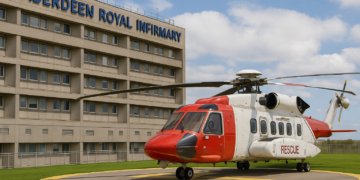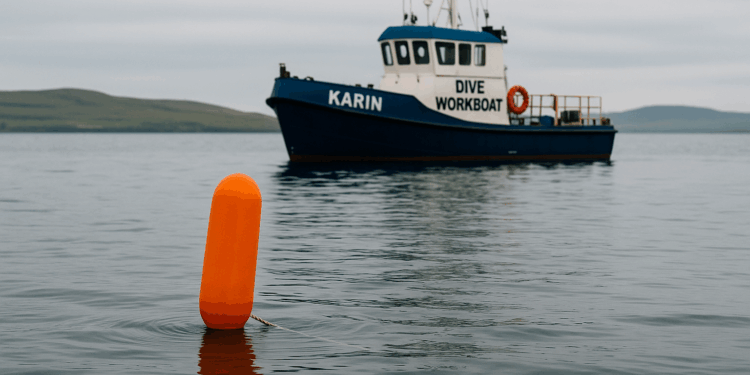Story Highlight
– Paul Smith, 70, died after diving accident in Orkney.
– Struck by propeller of dive boat Karin during dive.
– Investigation reveals safety protocols were not followed.
– Recommendations for improved safety measures in diving operations.
– Karin’s owner has exited recreational diving support industry.
Full Story
A recent investigation into the tragic death of recreational diver Paul Smith has raised significant concerns regarding safety protocols for diving operations in Orkney’s waters. Smith, aged 70, from Greater Manchester, was reported missing following a dive targeting the wreck of the German battleship SMS Markgraf in Scapa Flow. His body was subsequently discovered near the island of Cava, leading to a thorough probe by the Marine Accident Investigation Board (MAIB).
The MAIB’s findings indicate that Smith’s death resulted from a collision with the propeller of a dive support vessel, the UK-registered Karin, during his final decompression stop. At the time of the incident, he was submerged approximately three metres beneath the surface, accompanied by a diving partner. Smith was utilising a delayed surface marker buoy (DSMB), which should have signalled his presence to surface vessels. The buoy was visible, yet tragically, the crew of the Karin failed to see it and inadvertently motored over the line connected to Smith’s dive vest, leading to the fatal accident.
In response to the incident, Chief Inspector of Marine Accidents Andrew Moll OBE has emphasised the importance of stringent safety measures. He remarked, “Our findings highlight that all stakeholders, including operators, regulators, and industry bodies, must always prioritise the safety of those who are on the water, be it for work or pleasure.” Moll pointed out that adherence to established best practices such as vigilant watchkeeping and clear communication is crucial, especially when multiple vessels operate in close quarters to divers. He asserted that had these protocols been correctly implemented, this tragedy could have been averted.
The investigation report underscores the vital role DSMBs play in ensuring diver visibility and safety. While these devices are designed to enhance the visibility of divers to surface boats, divers must be proactive about their use. Moll specifically noted that divers should ensure DSMBs can be quickly released if entangled, preventing potential hazards.
Moreover, the report revealed that Smith sustained severe head injuries, with his remains located on the seabed following a focused search three weeks post-incident. It was noted that the skipper of the Karin did not maintain a proper lookout despite operating in a vicinity heavily populated with submerged divers. This oversight was further exacerbated by the concurrent operations of two dive vessels in the same wreck area, highlighting deficiencies in the existing safety measures governed by the Orkney Islands Council Harbour Authority.
The MAIB’s conclusions urge that skippers must maintain an effective lookout at all times, particularly when divers are in the water. They advocate for the establishment of a dedicated lookout positioned appropriately to warn the vessel’s helmsman of any divers surfacing nearby. The report also stresses that detailed and continuous communication between operators is fundamental when several boats are coordinating dives in a common area.
The Maritime and Coastguard Agency is set to intervene by directing all small commercial vessels to adopt a revised safety management system aimed at safeguarding divers in these waters. Meanwhile, the Orkney Islands Council Harbour Authority is in the process of finalising new directives pertinent to diving and other recreational activities.
As the investigation has drawn to a close, it was revealed that Johns Diving Charters, the vessel’s owner, has sold the Karin to a local operator while opting to retire from the recreational diving support sector altogether. This case serves as a reminder of the critical need for enhanced safety protocols and vigilance in maritime operations, especially in areas frequented by divers. Looking ahead, the hope is that lessons learned from this tragedy will foster improvements that safeguard underwater explorers and prevent similar incidents from occurring in the future.
Key Takeaways
– Paul Smith, 70, went missing after a dive in Scapa Flow and was later found dead, struck by a boat propeller.
– The incident involved the dive workboat Karin, which failed to see Mr. Smith’s surface marker buoy.
– The MAIB report indicates the tragedy could have been avoided with better safety measures and communication.
– Recommendations include a risk-based review of recreational diving operations by Orkney Islands Council.
– Emphasis on maintaining an effective lookout and implementing a revised safety management system for small commercial vessels.























This is a devastating reminder that complacency around basic watchkeeping and communication can be fatal. Operators must ensure clear procedures for tracking divers, use redundant systems to confirm buoy locations, and make sure every crew member understands their responsibilities on the surface. Regular training, effective briefings with divers, and a culture that empowers crew to speak up when something is not right are essential. The industry needs to adopt and enforce practical, consistently applied safeguards so that no one else is put at risk.
This tragic case underlines how essential basic watchkeeping and clear communication are to diving safety. A delayed surface marker buoy should trigger immediate checks and radio calls rather than being overlooked. Boat operators must maintain vigilant lookouts, establish and follow firm procedures for tracking divers in the water, and ensure every crew member understands their role in emergency response. Routine briefings, agreed hand signals and radio protocols, and drills for lost diver and propeller strike scenarios would reduce risk. Regulators and operators need to treat this as a wake up call to tighten standards, improve training and oversight, and make sure commercial pressures never replace the duty of care owed to divers.
This is a devastating reminder that complacency can cost lives. Proper watchkeeping and clear communication between the vessel and divers are non negotiable. Practical steps such as strict surface watch procedures, verified dive briefings, effective use of surface marker buoys and training for crew and skippers on diver recognition and vessel handling would reduce risk. Industry must take the MAIB findings seriously, adopt tangible changes and ensure accountability so that similar tragedies do not happen again.
This tragic incident underlines how essential strict watchkeeping and clear communication are on every dive operation. Surface marker buoys must be acknowledged and tracked, roles for lookout and boat handling should be defined and practised, and procedures for response to delayed or missing divers must be rehearsed. Operators need to ensure equipment and crew training match the risks of local conditions and that safety checks are carried out before and during each dive. Lessons must be turned into practical changes so that complacency does not cost lives.